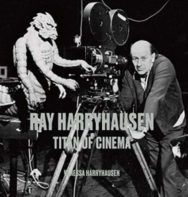‘I so admire all of Dad’s achievements, and am proud to see what a legacy he has left. It’s exciting to see that people are still fascinated by Dad’s work, more than seventy years after he first animated for a major film.’
The National Galleries of Scotland’s current exhibition pays tribute to one of cinema’s greatest pioneers, Ray Harryhausen. But if you can’t make it to Edinburgh while the exhibition is on (though it runs until September 2021), you can bask in his life and iconic work in the exhibition’s companion book, Ray Harryhausen: Titan of Cinema. We have a sneaky peek here to share with you, which we’re sure will bring back memories!
Extracts taken from Ray Harrhausen: Titan of Cinema
By Vanessa Harryhausen
Published by National Galleries of Scotland Publishing
Dad’s centenary
My dad, Ray Harryhausen, was known to his fans and moviegoers as a creator of magical creatures, and as the man behind the stop-motion animation technique Dynamation. He astonished and terrified his audiences with swordwielding skeletons, bronze giants and the iconic Kraken from Clash of the Titans. The 100th anniversary of his birth has given me the motivation to record the stories that reveal the kind, funny, fascinating family man behind these creations. With this book, I want to celebrate the fantastic collection of creatures and artworks which sprang from his incredible imagination. These are my own personal memories of this famous man’s life at home, as well as on set. Often, some of the people who knew him as a friend, colleague or mentor add their own revealing memories.
I so admire all of Dad’s achievements, and am proud to see what a legacy he has left. It’s exciting to see that people are still fascinated by Dad’s work, more than seventy years after he first animated for a major film. I still feel that what he created on screen was magical – from the initial seed of an idea in a drawing that sprang from his huge imagination to building a model which he then brought to life through animation. I had the opportunity of watching him create concept sketches and then construct the model at home. The creatures all had very strong personalities – Dad was always able to create such distinctive characters.
There are sixteen classic films that Dad worked on throughout his career; I was around for five of these, from One Million Years BC (1966) until his final movie, Clash of the Titans (1981). I was fortunate to be present on many of Dad’s film sets as a child, and mingled with the famous actors and crew who worked with him.
Once animation on the films had been completed, Dad would allow me to play, from an early age, with the very models that had been seen on screen. Our house was filled with items from Dad’s films, and so alongside my regular childhood toys, I was able to have fun with dinosaurs and other creatures – this was the norm for me. We also had some interesting reading material – Dad’s good friend Forrest J. Ackerman, the science-fiction writer and publisher, would send over copies of Famous Monsters of Filmland magazine, which we would read over breakfast, much to Mum’s disapproval. She just didn’t think it was right to have such gruesome reading material at the breakfast table!
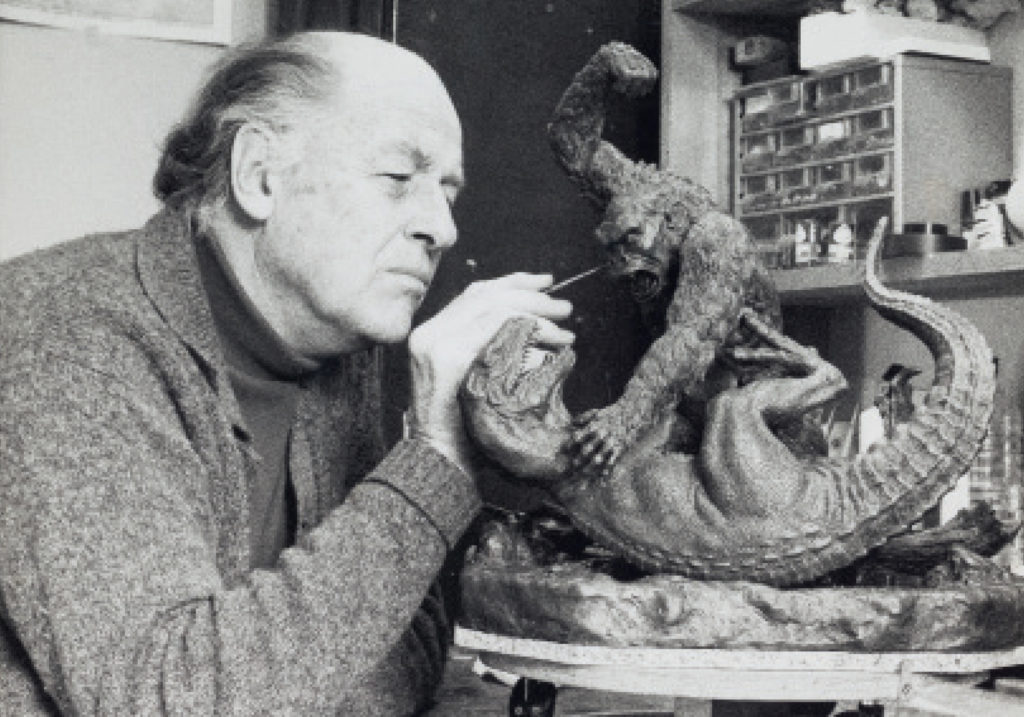
Skeleton model from The 7th Voyage of Sinbad
Of all Dad’s creations, it is the skeletons which are most frequently remembered by film fans.
Even though The 7th Voyage of Sinbad (1958) was before my time, the fight scene between Sinbad and the skeleton on a spiral staircase is particularly special to me.
The choreography for this sequence was incredible. I have been lucky enough to practise some basic swordplay with Scottish battle re-enactors in the past, and so appreciate the level of concentration and timing required by the actor Kerwin Mathews in this scene. Mathews would spend hours and hours rehearsing his movements with the stuntman Enzo Musumeci Greco; then, when it came to shooting the live-action sequences, Mathews would be alone, fighting his invisible foe. Of course, Dad then animated the skeleton model to match with Mathews’ movements, and the end sequence was brought to life by Bernard Herrmann’s score.
This sequence was so successful that Dad decided to use skeletons in his 1963 film Jason and the Argonauts. This original skeleton was reused, as well as six additional models. For many years, Dad claimed that he had forgotten which of his skeletons the original from 1958 was. However, as we prepared for our exhibition at the Oklahoma Science Museum, our conservator Alan Friswell realised that this particular model was the original, after some close examination. We decided that he should be reunited with his 1958 sword and shield, just in time for the film’s sixtieth anniversary.
Director John Landis on The 7th Voyage of Sinbad
A Hollywood producer once said: ‘Those who make movies are in the transportation business.’ That exactly describes my first encounter with the work of Ray Harryhausen – I was transported!
The eight-year-old me was no longer sitting in my seat at the Crest Theater in Westwood, LA: I was on the beach of the island of Colossa, and as awe-struck and fearful as Sinbad and his crew when the first Cyclops made his appearance. I was spellbound by Sinbad’s adventures, and marvelled at the Cyclops, the two-headed Roc, the fire-breathing dragon and the skeleton brought to life by the evil magician Sokurah. Only later did I learn that these extraordinary beasts were really brought to life by the magician Ray Harryhausen.
The 7th Voyage of Sinbad was a truly life-changing experience for me. Thrilled by the movie, I went home and asked my mother: ‘Who does that? Who makes the movie?’ She replied: ‘Well, a lot of people, honey, but I guess the right answer is the director.’
And that was that: I would be a director when I grew up. All of my energy went into that goal, and I read everything about film that I could get my hands on.
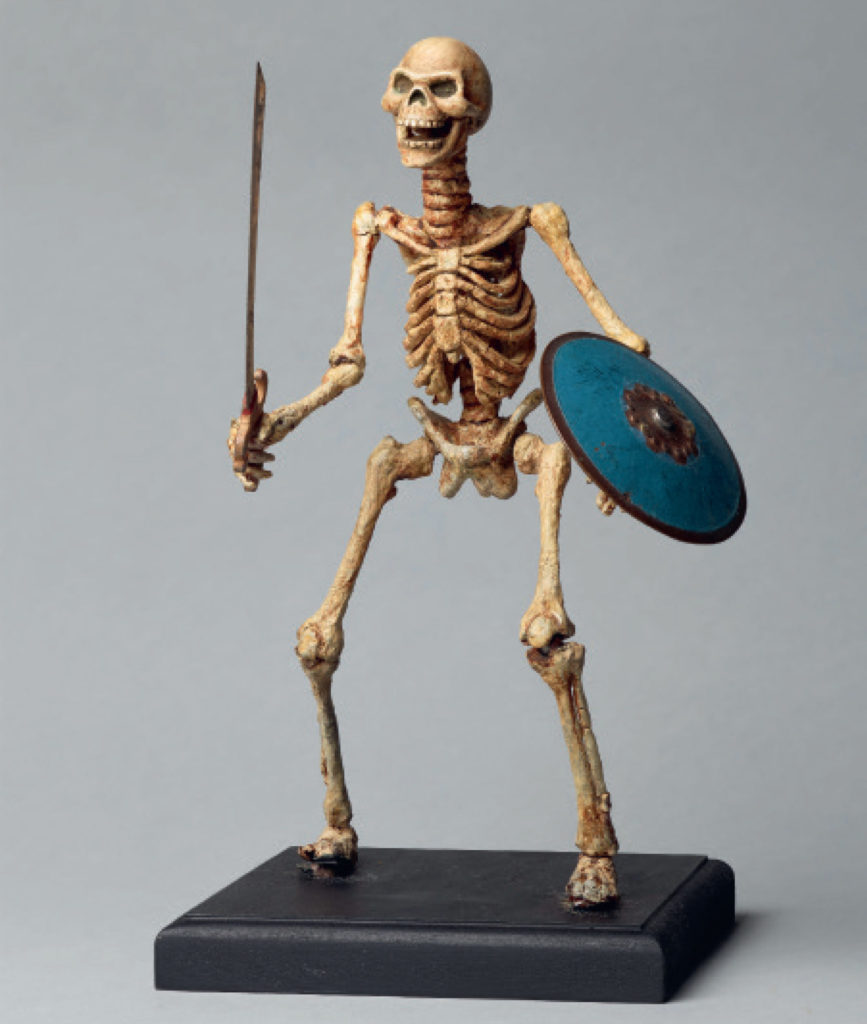
Minaton model from Sinbad and the Eye of the Tiger
The character of Minaton saw one of the rare occasions that Dad alternated between a stop-motion model and an actor in a resin suit. In this case, the actor was the 7-foot 3-inch hospital porter Peter Mayhew, who would go on to appear as Chewbacca in the Star Wars movies. This was his first film role, after Charles Schneer saw an article in a local paper about a particularly tall man with large feet. Everybody who worked with him said that he was a very gentle, kind man. When I met with his co-star, Kurt Christian, he said that he rarely complained during filming, despite the fact that he was in such an uncomfortable suit in the baking sun.
I thought that Minaton was a tremendous character – he looked as though he had been constructed from bronze, and I love the dramatic scene where Margaret Whiting’s character Zenobia brings the creature to life. I remember meeting Margaret on set – I thought she was lovely, and fantastic as the female villain in Dad’s third Sinbad film.
Dad asked me to take care of the Minaton’s head that Peter Mayhew had worn for the role, many years after the film had been released. I lived in Scotland by this time, and our estate had a little more wall space than Dad’s house in London. He suggested that I mount the head like a hunting trophy, and display it alongside the stag heads, swords and targes that were up on the wall already. The head is made of fibreglass, and so is not particularly heavy – however, there are no holes for air or sight, and so I can’t imagine what it would have been like to wear on location. Thankfully, I don’t think Peter had to wear it for long.
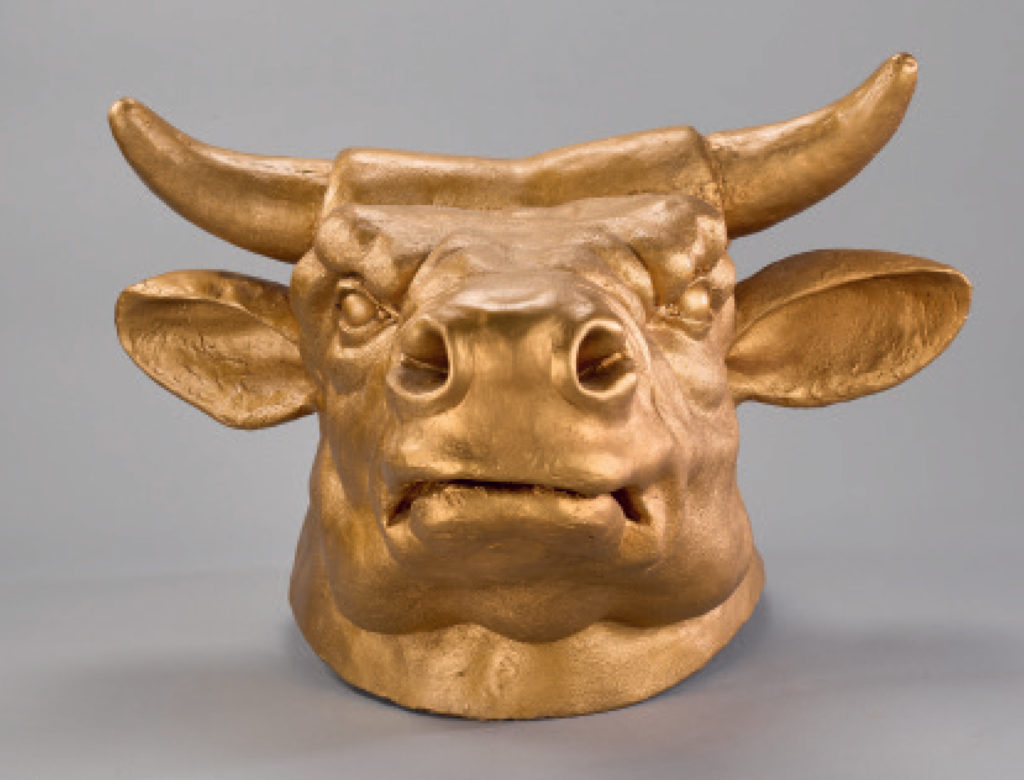
Medusa model from Clash of the Titans
This is one of Dad’s most complicated stop-motion models. I remember him creating a key drawing of Medusa on his easel in his workshop at home – I returned home from boarding school just in time to see the artwork being finished. At the time, Dad was debating whether to include a ‘boob-tube’; he was concerned about American censors raising objections to a topless Medusa, regardless of the fact that she was a reptilian creature. In the end, it was decided that the garment should be removed; Dad felt that this allowed for a more authentic and effective Medusa.
I was on set during the filming of the live action for Medusa at Pinewood Studios near London, and remember the sequence where Medusa’s arrows were taking out Perseus’ companions, one by one. The scene where a supporting actor receives an arrow to the back and falls face down into a pool of water in Medusa’s temple required multiple reshoots, and I recall feeling very sorry for the actor, who was repeatedly dunked into the somewhat murky water!

Photographing Medusa, by Andy Johnson
I was captivated by the model of Medusa, which I vividly remembered from Clash of the Titans (1981). It was quite scary as I recall, but here I was carrying the piece to set up for photography. We were going to ask Ray to stand behind Medusa and move her as if he was working on a film sequence. I was so concerned that this fragile model would come apart or be damaged, but Ray began to move the various articulated joints through their sequences, and all seemed fine. We wanted to create a small sequence of movements to emulate the way it was photographed for the film, twenty-four images in a second. It was at this time that I fully realised how difficult it must have been; there were a dozen or so snakes on her head to manipulate, the arms, facial expressions, tail; and all the while, keeping them all moving in the correct direction – quite unbelievable.
Colin Arthur on Clash of the Titans
Ray and I worked together on Clash of the Titans. Again, he produced a waterfall of inspired drawings and visited my studio while I sculpted the Kraken and made some full-sized two-headed wolves. With the Kraken completed and in store, and an assistant finishing the wolves, I went off to shoot a Burt Lancaster film. But soon, calls came in looking for the Kraken for shooting in Rome. I loaded all Ray’s monsters, the Kraken and my tools into my Winnebago and drove to Rome. A mammoth trip in a very short time, leaving on Saturday and arriving in Rome on the Monday – Ray had summoned me!
As shooting drew to an end, we began to plan the make-up for the character Calibos, with his goat’s legs. I was keen to do the whole sequence for real with an actor and prosthetic goat’s legs, but in the end Ray decided to stay with stop-motion, and I did the close-ups. We were working on a very tight timescale, and we had little time to do the finishing work. Thank goodness for the wonderful Ted Moore, our lighting cameraman – Ted would say ‘no problem’ and, with subtle shadows and clever lighting, make things better than I had dreamed possible.
Ray was always there too and was concerned about the mix of techniques that were involved, but in the end we had a relaxed shoot. When the film was released, Ray came to me and admitted that the goat’s legs would have been more interesting with prosthetics and not stop-motion – but that was the way of our work, constantly breaking new ground, using unknown and unconventional materials, trying new ideas.
Alas, Ray’s next project never came to pass, and the technology changed into real-time special effects, then CGI and Star Wars, and the world changed for us. It was time to bow out graciously.
It also meant that I could then be in the UK, spend time with Ray, and indirectly give a small amount of support to the Harryhausen Foundation – what a pleasure to spend time with him, an old comrade and so much more than just a friend.
Ray Harrhausen: Titan of Cinema by Vanessa Harryhausen is published by National Galleries of Scotland Publishing, priced £27.95.
ALSO IN THIS ISSUE

 Clanlands
Clanlands
‘No other drink is named after a country, which is why whisky is more than just a drink for me. When …
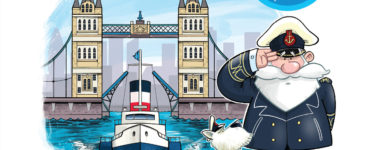
 Captain Bobo and Friends
Captain Bobo and Friends
‘It’s a world of brass bands, lost teddy bears, shy puffins, fluffy sheep, missing dinosaurs, cream …





